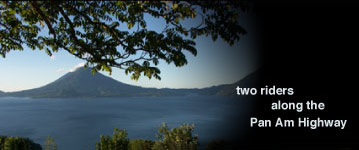
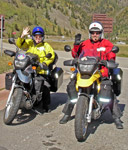
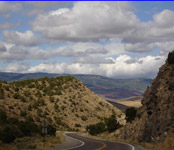
view corresponding gallery | previous entry | next entry
entry 15: guatemala 02/18/06
Photo note - Thanks to the rain and flooding in Belize, I've been working on getting larger images for the photos on the journal pages. You can now click on the photos below to make them larger. Enjoy!
The border crossing from Belize to Guatemala took a total of 90 minutes. Upon reaching the border, we were immediately approached by money changers and tramadors (border guides) but we declined their offer of services and found the paperwork to be straightforward and fast on the Belize side. After paying an exit tax of $18 each, we rode under the border arm and into Guatemala. The first stop you have to make is the “sanitation station” where they spray the lower part your car/bike with something that is supposed to stop pests and germs from entering the country. Lynne sort of rode past the station, not being too keen on getting something unknown sprayed on her bike and as I approached the station the guy with the hose was pretty determined that both of us were not going to get past him. I ended up paying 10 quetzals (about $1.25) per bike and they didn’t seem to mind that Lynne’s bike wasn’t sprayed as long as they got paid. I watched the bikes while Lynne got tourist visas and vehicle permits for the bikes.
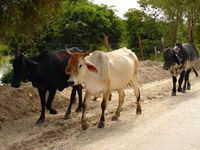 |
| Oncoming traffic - Guatemala style. Just a few more reasons to stay alert on the road. |
You can tell immediately where Guatemala begins because the asphalt disappears and dirt roads start. We headed toward Flores and the road improved a bit after the first 15 miles. We took a big left and headed south on the only main highway in northern Guatemala. The day ended in the town of Poptun, where Lynne spotted a small roadside sign that advertised a hotel just off the highway. It had been raining on and off most of the afternoon which made the dirt road we were on quite sloppy - and after about a half mile we thought we were lost. But some help from the locals got us to the right place and they must have seen us coming as the big iron gate at the entrance rolled back and they directed us to park under their laundry on the clothes line! Most homes here don’t have clothes dryers and any covered patio also doubles as the clothes line area. We soon added our wet riding gear to the lines. As we unpacked the bikes our next-door neighbors came over and introduced themselves. It turns out that they had two sons who are attending a local school that teaches modern agriculture and is run by the Church of the Seventh Day Adventists. We struck up a conversation and they asked if we would like to go with them to see their church and school. I declined but Lynne said O.K. and 5 minutes later she was getting into a truck with them. Sooo, I figured how much trouble could she get into with a church group?? So, I had dinner and waited for my wife to return, which she did about 3 hours later.
Our hotel room in Poptun was the first of many that had mold, cracked paint, no hot water and of course the ever present wastebasket by the toilet. More on that subject later. The people, however, were great. We rely daily on their patience ("Did he just ask for a room and two donkeys?"), directions (we’ve had three police escorts through busy towns), and their interest in our trip ("You rode from where?").
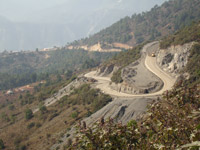 |
| Looking down on roads to come - at least this is a two-laner! |
We had done some research on Spanish schools and decided to make our way to Quezaltenango, a fairly large town in western Guatemala, to attend a language school. After consulting our ITM map (one of the better maps available) we chose a “secondary road” that would keep us well north of Guatemala City (and its renowned traffic) as well as shave off several hundred miles of riding. As we approached the area where the map indicated we should find our road, we spot no road-signs and pass no roads that would lead us west. Once again we asked directions from a local and he said “The road you want is back up the road, next to the Shell gas station.” So we find the Shell gas station but still don’t see a road. When we ask one of the Shell attendants, he points at a small gravel road that leads up a hill. Not being too keen on riding anymore gravel roads, we ask how long it remains gravel and he replies “About 40 kilometers (about 25 miles) then it turns to asphalt.” We decide the trip over the gravel portion will be worth the time and distance that we would save over going the long way around through Guatemala City (can you say bad decision?). So off we go down a road that is at best one-and-a-half cars wide and consists of mostly 4-6 inch stones that are set in dirt and spaced about six inches apart. Most of the time we have the bikes in first gear, going along at about 15 mph. There is little traffic and the countryside consists of palm trees and corn fields (not that there is much opportunity to gaze at the countryside while you are trying to keep the bikes upright). As we gain altitude we pass valleys and small streams, some of which cross the road - but are never deep or too wide for us to ride through. After using a lot of upper body muscles to avoid the larger rocks and ruts, we are ready for a roadside rest and we find a level point in the road to park our bikes.
We didn't really notice that we had stopped in front of a farm house and so we were a bit surprised when someone called out to us and invited us up to their porch to sit in the shade. Once again Lynne was the chatter box and I the smiling, nodding partner. These folks were very interested in what we were doing and they made it clear that it was only once in a blue moon that any tourists passed their way. As we were preparing to leave one young man showed us a small cup that he had found up in the hills. It had a Mayan God carved on the outside and looked pretty old. We had seen several of these in museums and he told us that they find them now and then in the nearby hillsides. It was one of those moments when you see an indigenous Mayan holding his ancestors’ handiwork that make the rough road worth taking.
Back on the bikes we traveled until we have gone a total of 40 miles on gravel. No asphalt and we had been riding for 4 hours. It was 2pm when we pulled into another town to ask about the road ahead. Another helpful soul tells us the road turns to asphalt after another 12 miles. Twenty miles of jaw jarring, hand numbing road later we hit pavement in the town of Fray Bartolome de Las Casas. It was 4:30 in the afternoon and we were pretty whipped. We found a hotel and unloaded our bikes. Of course there was no hot water but our bodies were so warm from the ride that the cold shower actually felt great and helped to revive us. We had a dinner of roasted chicken, refried beans and tortillas and consume about 6 bottles of water trying to replace lost fluids.
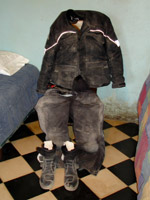 |
| Somewhere under that dust is Lynne's black riding suit. |
We got up the next morning; took four aspirin to quiet the screaming muscles and headed back down the road. We get gas (averaging about $3.15 a gallon) at the edge of town, confirm that the road ahead is the right one and head off. Two blocks later the town ends and so does the pavement. We are both swearing quite a bit and we pull back into the gas station and ask them how far it is before we hit asphalt - “25 kilometers, senor.” Now where have I heard this before? Not only does the road still resemble a cheese grater on steroids, but we are stopped about 5 miles down the road because of road construction. I use the term road construction loosely because they are not really building a road but rather repairing the dirt one that extends as far as we can see. I should mention that last fall, Hurricane Stan came through Guatemala and the massive rainfalls caused several large landslides and washed out most of the bridges on this road. The Guatemalan Highway Department has their hands full just trying to get things back the way they were. This time we are delayed an hour and then continue up into the mountains where at this point the views are now all looking straight down the side of this mountain range. My GPS shows us to be traveling from altitudes of 6,000 to 8,000 feet and the road is now truly single lane. Forget about guard rails and “Dangerous Curve Ahead” signs or any signs at all. We try to avoid traveling behind anyone because of the clouds of fine dust that hangs in the still air.
We pick the best hotel we can find out of our Lonely Planet guide book and ask a lady on a moped where it might be. She says “No problem, I’ll show you.” And she proceeds to take us on a 30 minute tour of Coban and then we lose her in the crowds. Finally we dig deep into our souls and come up with a trick we had seen on the reality show The Amazing Race and we find a taxi and pay him 3 bucks to leads us to the hotel. A hot shower, a cold Coke and more roasted chicken leads us to an early bed.
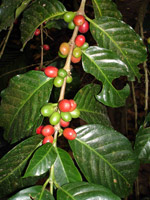 |
| A ripening coffee plant on the Finca Santa Margarita. |
Coban is a fairly non-descript town of about 20,000 souls, but our bodies needed some recovery time and there were a few interesting points to the town so we decided to stay for a few days. A visit to the orchid nursery, Vivero Verapaz, resulted in a guided tour of THOUSANDS of varieties of orchids. From orchids the size of your head to ones so small you almost had to squint to see them, this nursery seemed to never run out of new varieties. After that we went to a working coffee plantation. The Finca (farm) Santa Margarita was founded in the 1880’s by a German immigrant and the original farm house is still in use today. I found several interesting things here. Thanks to Juan Valdez and the Folgers Coffee commercials, I already knew that coffee beans are ready to pick when they turn red - but I was surprised when our tour guide picked one and asked us to split it open and taste the inside. It turns out that there is a sweet, juicy section between the “bean” and the skin. They make jelly out of that part. The other agricultural revelation was to find out that other types of berry plants are planted among the coffee plants to entice the robber birds away from eating all the coffee beans. There was so much more than coffee plants on this farm - I found out that avocado plants are really trees and the ones we saw were as large as or larger than any elm tree I’ve ever seen, at least 70 feet tall. I asked if they just pick up the ones that drop and our guide tells us that some of the guys climb up and harvest them once a year. Not this guy!
The couple of days in Coban also gave me a chance to wash and check the bikes over. My inspection revealed that both of our front fenders were hanging on by just one of the four screws meant to secure the fender to the front fork brace. I removed the front tires, removed the fenders completely and replaced the front tires. I packed them behind me on the bike as I’m sure they should be put back on at some point when new screws become available.
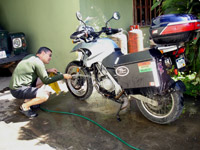 |
| What the hell happened to the front fender? |
Once more on the road, once more having been told that better roads are just 10 miles down the road, we travel another 30 miles in 3 hours - mostly downhill on either powder fine, front wheel grabbing dirt or detours around land slides. We have had the bikes slide out from under us several times now on hairpin curves, once to avoid an on-coming pickup truck. On another occasion we have to stop the bikes and turn around to find a wider spot in the road because the large dump truck coming up the hill consumes the entire road. The road continues on this way for what seems an eternity - and since our 8am start, we have been stopped three times for road construction, crossed four small streams (one deep enough to come to the tops of our riding boots) and have traveled only 60 miles in 10 hours. We can go no further for fear of not reaching a town by sunset so we stop at the town of Uspantan. Thank goodness we did because the next morning was more of the same. Several hours later, when we are finally within site of asphalt we are told that there is a three hour delay for more road construction. Crap. We are in 90 – 95 degree sunshine and we just about lose it. Fortunately the flag man takes pity on us and we are allowed to follow the company pickup truck through the new asphalt sections (missing the tar sections, thank God) and we are finally doing 30 to 40 mph and the breeze feels wonderful! We made good time from there and make it to our school destination in the town of Quezaltenango. As we are riding through town I noticed a horrible grating sound coming from my rear brake. I inspected the pads and found that they were completely worn down. My disk was grooved and there was no brake fluid in brake fluid reservoir. The short cut we took here had now consumed five days, two front fenders and a rear brake.
Quezaltenango sits in a high mountain valley, about 7,400 feet above sea level, and has quite a few Spanish language schools. We chose one that was close to our hotel called Utalan and started our one week of classes on Monday. The first few days were a bit dicey as we picked up our first bout of “tourista”. So we took the advice of our doctor in Denver and spent two days on a clear liquid diet (he recommended three, but we didn’t make it). Anyway, 48 hours seemed to straighten things out. We spent the week going to class from 9 am to 1 pm, had our one meal of the day at either a great chicken restaurant chain called Campero or a McDonalds. Yes, after several months out of the country, we have no pride about seeking a burger fix whenever we can find it. School was great and my teacher, Juan Carlos taught me a few things about football (soccer in the states) and the week flew by. The only real complaint about our stay in Quezaltenango was the pollution – both air and noise. Our hotel room (actually a suite of two rooms for $25) was right on the central square. All week, smog and noise filled our room pretty much 24/7. Cold air inversions, just like in Denver, cause car fumes and smoke to get trapped close to the ground and in cities that use wood as a main source of fuel for cooking, well, it can get pretty thick.
I had not had any luck locating a shop to look at my brakes in Quezaltenango - finding only moped and small bike shops in town. So, on Saturday we took off for Guatemala City – a city we had originally planned to by-pass, but with our bikes in need of some TLC, we initiated “Plan B” once again. We took the four-hour ride slowly and I gave extra room between myself and Lynne. The road was in pretty good shape and we had no big surprises. After three weeks of questionable nights sleep, we decided to splurge when we hit the city and checked into a Radisson hotel.
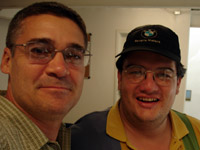 |
| Tom and Jose at Bavaria Motors in Guatemala City . |
We took our bikes to Bavaria Motors, a BMW shop and there we met Jose Del Busto, a person who was highly recommended to us by Maggie and Norman, the fellow F650 riders we had met up with in Mexico. Jose was great, giving us contacts for further down the road, free rally t-shirts - and he even hand-made a couple of cool stickers for our panniers! He also introduced us to his retired boss, Arnie, who took the time to lead us over to their repair shop. Arnie had just returned from a solo trip to Argentina and had a lot of good info on sites for us to see. When I returned to the shop after the bikes were finished to tell Jose thanks and good-bye, he said something that really hit home - “The reason I do this job is because of people like you. People who are out there doing their adventure of a lifetime.” Thanks Jose – it is people like you who make it all possible. And thanks for taking such good care of our bikes. My bike had its rear brake pads and disc replaced plus both bikes had their 12,000 mile maintenance performed. The tune ups were $200 a bike and my brake repair was $300. No charge for re-installation of the fenders! The tires have shown very little wear after 6,000 miles so they recommended we go with what we had.
With the bikes running great and looking cleaner than they have since leaving the Denver showroom, we headed out for El Salvador.
Lynne on Guatemala:
Highlights of Guatemala included some fun learning in Xela (pronounced shay-lah, this is the better known, and much shorter, Mayan name for Quezaltenango). Tom and I both had good instructors and learned a bunch – Tom about all the intricacies of the game of soccer and me about the local social systems. Muchisimas gracias a Herson y Juan Carlos!
Another great find in Xela was Alice – a message therapist from Portland who gave hour-long massages for $10. She was a true gift from heaven. Look for her in the green building marked "Chili Tours".
Lowlights of Guatemala all involved what I would loosely refer to as roads - and I have little good to say about the ones that we encountered. If the raw composition of the dirt/rock (mostly rock) secondary roads doesn’t shake the muscles right off your bones, then the lunatic drivers of the chicken buses on the highways will make you wish they had. Oh, and both road varieties are twisted and vertical more often than not. Tom refers to these as "butt puckerers" - and I'm pretty sure this is because he is behind me watching me navigate them.
Meeting part of the BMW family of Guatemala City was great. Jose and Arnie both speak English very well and are devoted to encouraging tour-riding down here. Should you find yourself in the area, they are a wonderful stop along your ride.
Mild bouts of “tourista”, colds and exhaustion from the hot, dusty rides kept us pretty low-key in Guatemala. But I am grateful for the necessity of our last-minute diversion to Guatemala City. The bathtub, hot water and crisp white sheets at the Radisson damn near brought tears to my eyes. We stayed in a lovely part of the city and had some really great meals. And, of course, I did find time for a bit of shopping. It was a great way to re-coup before heading out of the country.

Copyright © 2005 All content and photography are the property of Tom and Lynne Gefre.
Contact us if interested in publishing or reusing any material.